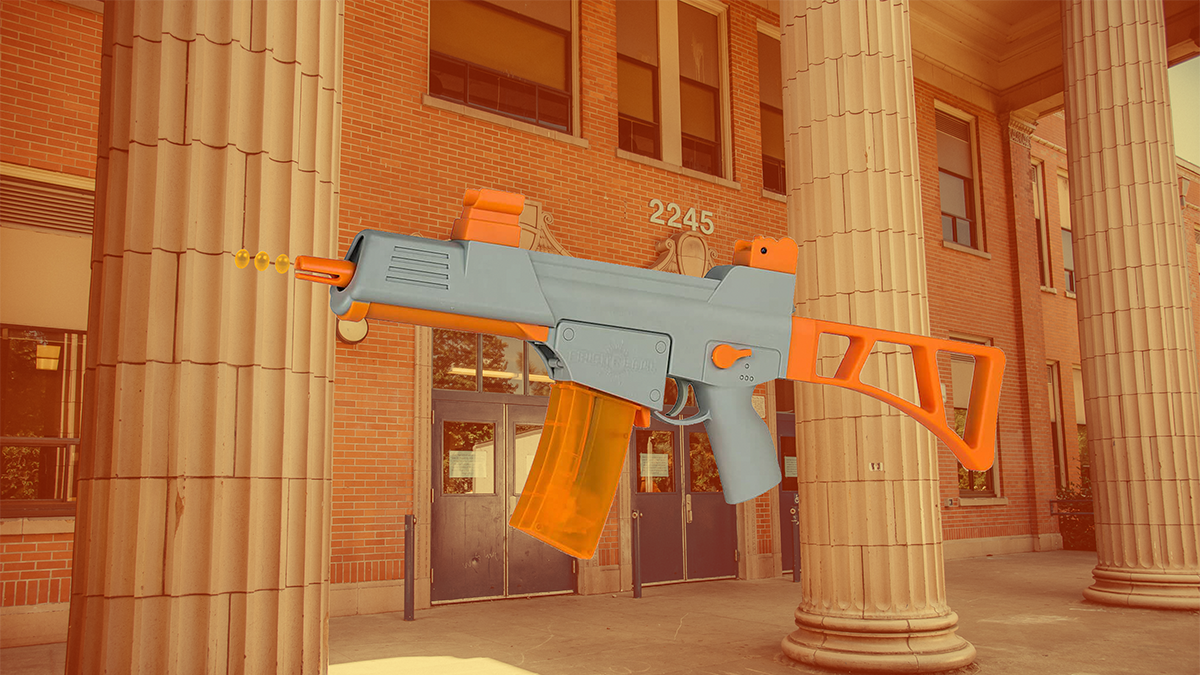The lunch hour when Noah Carr was shot in the face with a gel gun began in the ordinary way.
Scores of Grant High School students power-walked to Blind Onion for pizza and breadsticks or to New Seasons for salad rolls during their 35-minute window for lunch.
But on March 10, six students broke from their usual routine. Armed with SplatRBall guns—which look like semi-automatic rifles but shoot small gel balls filled with fluid—they split into two cars and prowled the streets around Grant, shooting students at random as they drove by.
When they hit Carr, a sophomore, they lit a fire under a Grant teacher and his wife.
Since the incident, Noah’s dad, Jon Carr, who teaches English at Grant, and his mom, Amy Potter, have tied the incident to what they feel is a much larger issue: the secretive nature of disciplinary proceedings at Portland Public Schools.
“I’m not satisfied with the district’s response,” says Potter. “There has still been no harm repaired to the students and staff and community members and people he harmed. Their communication needs to be public and transparent to the entire community.”
The use of gel guns by high schoolers became a nationwide trend earlier this year, apparently stemming from a TikTok challenge. Shootings with gel guns were reported in Georgia, Florida and California.
This week, Portland Public Schools confirmed to WW the suspicions of parents: SplatRBall guns had spread across Portland schools, too.
“We have seen reports of incidents involving airsoft and splatzball guns with some of our students,” says district spokesman Ryan Vandehey. “Possession of weapons, or articles that resemble weapons, may lead to student discipline or other interventions.”
PPS would not disclose the scope of the trend—nor would the district reveal how many incidents had occurred or at which schools.
The district did not answer most of WW’s questions, including how students were disciplined and whether the district had beefed up security in the wake of the shootings. (Principal James McGee wrote to parents after the shootings on March 10 and said they had reported the incident to law enforcement and district security.)
The gel balls don’t normally break skin, and they rarely cause severe injury.
But gel guns, even from a short distance, resemble assault rifles—the type of firearm used in nearly all U.S. mass shootings, including the recent slaughter of 19 children and two teachers at a Uvalde, Texas, elementary school.
The similarity is not lost on students and parents at Grant, who might have once dismissed SplatRBall shootings as obnoxious horseplay but now demand that the school district take them seriously.
The mother of another student who was shot March 10 requested anonymity so her son wouldn’t be targeted again. A junior at Grant this year, he was hit at least five times as he walked back to school along Northeast 33rd Avenue. He says most of the shots hit his jacket, but one hit him in the neck—and it stung.
“All we’re asking for is clear accountability and an apology,” his mother says. “In the world we live in today, with the increase in violence, it is really difficult not to imagine that this could be a precursor to something worse. You can’t ignore this.”
WW spoke to one of the students who participated in the SplatRBall shootings. The student, whose name WW is withholding because he is 16 years old, estimates he and his friends, all Grant students, shot around 60 people, most of whom were fellow high schoolers.
“[We] came to school kind of prepared. We all kind of talked about it and were like, ‘Let’s do this. It’ll be awesome,’” he tells WW. He had bought a SplatRBall gun the day before and tested it on himself to see how it felt. (Verdict: It didn’t hurt too badly.)
A video taken by a shooter from inside one of the cars shows four high school boys shooting bright orange guns out the window as they drive down 33rd. The guns make the signature popping noise of an authentic firearm. After the car passes and shoots at the crowd of students lined up outside of Blind Onion, one of the boys in the car yells, “Nobody’s safe, man!”
Much of parents’ frustration stems from the district’s refusal to disclose what specific disciplinary action was taken against students involved in the incident.
“It is our long-standing practice that we do not share details about incidents involving students, due to student confidentiality,” Vandehey says.
But the student whom the district identified and punished spoke to WW about what he did March 10 and was also willing to say how the school disciplined him.
He says his gun was confiscated, he was suspended for two weeks, and he had an expulsion hearing that resulted in two weeks of classes in a disciplinary program that trains students in conflict and emotional regulation. The student was not expelled.
He says he “kind of realized how dumb it was” and that he didn’t intend to shoot random people again.
The student who estimates he and friends shot about 60 people that day tells WW: “I think he learned like, maybe you shouldn’t do that. Like he learned from it, but I wouldn’t say he regrets it, just because it does seem harmless.”
When WW told parents the scope of discipline that students had received, several said it sounded fair.
But Noah Carr’s parents are not satisfied. They say the issue is larger: The district is breaking its promise to include victims in the school disciplinary process.
Since early May, the Carr-Potters repeatedly asked administrators to use a “restorative justice process” to resolve the problem but say their requests have been ignored. (Their emails were shared with WW.)
The Carr-Potters say Grant administrators characterized the discipline as a “restorative process.” But that usually includes a session in which the perpetrator and victim speak in the presence of a mediator—and Noah Carr was never invited to such a meeting.
Starting three years ago, the district reworked its disciplinary approach to emphasize restorative justice over punishment. But as Oregon Public Broadcasting reported last year, the district has struggled to consistently follow through with its new framework.
Last year, WW reported on high schoolers naming their alleged sexual abusers on Snapchat (“Snap Judgment,” WW, Sept. 1, 2021). Two students told WW they felt ignored by Portland Public Schools, and three others said they didn’t file reports because they didn’t think they would be investigated adequately.
After meeting with a Grant administrator on May 13, the Carr-Potters were told the school would not be taking any further action on the issue.
On May 17, they penned a letter to both Grant and district administrators that outlined their concerns, and included two action steps: that a Grant counselor reach out to all affected students and ask what response they’d like to see, and that Grant administrators make the perpetrators write a letter of apology to the harmed students and the entire school.
They threatened to press criminal charges if their requests were ignored. “This is NOT what we want to do,” they wrote.
Neither of those demands were met. The Carr-Potters have since filed a police report.
In written correspondence with the district, Jon Carr says PPS’s light touch on the gel gun shootings endangers the shooters as well as their targets.
Carr wrote that in May he witnessed a group of Grant students shooting each other with gel guns in a McDonald’s parking lot near the school. The guns, Carr says, were realistic-looking.
All of the students were Black, he wrote. “I hope that I do not need to go through all the examples of young Black men being shot and killed either by police officers or members of the public who ‘fear for their lives,’ when they see a young Black man with what appears to be a gun,” he wrote. He says he did not receive a response.
The district has an entire summer to figure out how to pacify parents; the school year ended just last week.
“We take these types of incidents very seriously,” PPS’s Vandehey says. “We care deeply about our students, and we are committed to their safety and well-being.”


